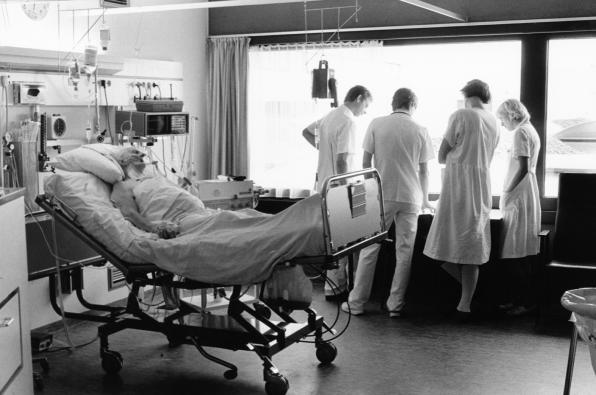Short abstract
Doctors in Britain are expected to attempt resuscitation unless patients have agreed do not resuscitate orders. If patients are terminally ill, is discussion of such orders harmful or helpful?
Patients increasingly want to participate in decisions about their medical treatment. Although this is appropriate in most circumstances, discussing cardiopulmonary resuscitation with terminally ill patients is not practical, sensible, or in the patient's best interests. In these special situations, patient involvement is tokenism and entirely of negative value.
The UK guidelines on cardiopulmonary resuscitation require doctors to attempt resuscitation in all patients who have a cardiac or respiratory arrest unless a do not resuscitate order exists.1 Doctors are required to discuss the value of resuscitation with their patients before making a do not resuscitate order (box). However, discussion about cardiopulmonary resuscitation forces the patient to confront the inevitability of their fate, with negative consequences. Patients need to maintain some hope—if not for a cure then at least for some comfort. It is not appropriate that all comfort is lost as a result of the inappropriate blanket application of a facile rule. This is particularly true when the rule forces patients to make a choice, when in reality they have no choice.
Medical futility
Another argument for not discussing resuscitation with terminally ill patients is medical futility. This term is applied to justify withholding treatments in patients who are likely to gain minimal benefit. Nowhere is the futility of medicine so clearly embodied as in resuscitation procedures for terminally ill patients. In a study of 243 patients who experienced a cardiac arrest and received cardiopulmonary resuscitation, 16 survived to be discharged from hospital. All of these patients were within a group of 73 who had had unexpected cardiac events. None of the 171 patients with terminal cancer who had cardiopulmonary resuscitation survived.2 In a smaller series of 83 cancer patients who had had a cardiac arrest, eight left hospital, of whom three died within six weeks and two within six months.3 The survivors were not terminally ill at the time of their arrest.
Much emphasis has been placed on patients' feelings with regard to clinical decision making, but we should also be concerned about the feelings of doctors and their views of procedures that they may not consider to be in patients' best interests. Resuscitation is traumatic, and failed resuscitation awfully traumatic. So why should clinicians be expected to carry out cardiopulmonary resuscitation on a patient dying from cancer?
Patients' views
The Study to Understand Prognoses and Preferences for Outcomes and Risks of Treatment found that 33-50% of patients with metastatic cancer wanted do not resuscitate orders in the 3-6 months before death.4 Our experience indicates that demand for autonomy and informed choice from patient groups has not been matched by a parallel appreciation of the likely consequences of resuscitation. Television drama has contributed to an optimistic lay view of the potential success of cardiopulmonary resuscitation.
There can be dignity in death and dying, but surely this is not the case when Cheyne-Stokes breathing stops and a team of doctors starts cardiopulmonary resuscitation. Let us leave patients who are expected to die to do so in peace and allow doctors to uphold the tenet, “first do no harm.” When people are dying, it is entirely ethical not to discuss resuscitation with them.—Charlotte Manisty, Jonathan Waxman
Figure 1.
Credit: HORACIO SORMANI/SPL
Summary of BMA, Resuscitation Council, and Royal College of Nursing guidelines on do not resuscitate orders
All medical establishments should have a “do not resuscitate” policy
Do not resuscitate considerations are embodied in the European Convention on Human Rights
Resuscitation should be discussed with competent patients or people close to them
Do not resuscitate orders should be made after considering likely outcomes, patient's wishes, and the patient's right to life
Do not resuscitate orders should be communicated to all relevant health professionals
Patients and their relatives should be given a realistic view of the effectiveness of cardiopulmonary resuscitation
Doctors cannot be required to give cardiopulmonary resuscitation contrary to their clinical judgment
Competing interests: None declared.
References
- 1.BMA. Decisions relating to cardiopulmonary resuscitation. www.bma.org.uk/ap.nsf/Content/cardioresus?OpenDocument&Highlight = 2,cpr (accessed 8 August 2003).
- 2.Ewer MS, Kish SK, Martin CG, Price KJ, Feeley TW. Characteristics of cardiac arrest in cancer patients as a predictor of survival after cardiopulmonary resuscitation. Cancer 2001;92: 1905-12. [DOI] [PubMed] [Google Scholar]
- 3.Varon J, Walsh GL, Marik PE, Fromm RE. Should a cancer patient be resuscitated following an in-hospital cardiac arrest? Resuscitation 1998;36: 165-8. [DOI] [PubMed] [Google Scholar]
- 4.Haidet P, Hamel MB, Davis RB, Wenger N, Reding D, Kussin PS, et al. Outcomes, preferences for resuscitation, and physician-patient communication among patients with metastatic colorectal cancer. SUPPORT investigation (Study to Understand Prognoses and Preferences for Outcomes and Risks of Treatment). Am J Med 1998;105: 222-9. [DOI] [PubMed] [Google Scholar]



